How to Install LEMP Stack on Ubuntu 24.04 Server/Desktop
This tutorial is going to show you how to install LEMP stack (Nginx, MariaDB, and PHP8.3) on Ubuntu 24.04. A software stack is a set of software tools bundled together. LEMP stands for Linux, Nginx (Engine-X), MariaDB/MySQL, and PHP, all of which are open source and free to use.
It is the most common software stack that powers dynamic websites and web applications.
- Linux is the operating system.
- Nginx is the web server.
- MariaDB/MySQL is the database server.
- PHP is the server-side scripting language responsible for generating dynamic web pages.
Requirements
To follow this tutorial, you need an Ubuntu 24.04 OS running on your local computer or on a remote server.
If you are looking for a virtual private server (VPS), I recommend Kamatera VPS, which features:
- 30 days free trial.
- Starts at $4/month (1GB RAM)
- High-performance KVM-based VPS
- 9 data centers around the world, including United States, Canada, UK, Germany, The Netherlands, Hong Kong, and Isreal.
Follow the tutorial linked below to create your Linux VPS server at Kamatera.
Once you have a VPS running Ubuntu 24.04, follow the instructions below.
And if you need to set up LEMP stack with a domain name, I recommend buying domain names from NameCheap because the price is low and they give whois privacy protection free for life.
Step 1: Update Software Packages
Before we install the LEMP stack, it’s a good practice to update the repository and software packages by running the following commands on your Ubuntu 24.04 OS.
sudo apt update sudo apt upgrade -y
Step 2: Install Nginx Web Server
Nginx is a high-performance web server and is very popular these days. It also can be used as a reverse proxy and caching server. Enter the following command to install Nginx Web server.
sudo apt install nginx
After it’s installed, we can enable Nginx to auto-start at boot time by running the following command.
sudo systemctl enable nginx
Then start Nginx with this command:
sudo systemctl start nginx
Now check out its status.
sudo systemctl status nginx
Output:
● nginx.service - A high performance web server and a reverse proxy server Loaded: loaded (/lib/systemd/system/nginx.service; enabled; vendor preset: enabled) Active: active (running) since Fri 2024-05-10 14:11:43 UTC; 3s ago Docs: man:nginx(8) Process: 8533 ExecStartPre=/usr/sbin/nginx -t -q -g daemon on; master_process on; (code=exited, status=0/SUCCESS) Process: 8545 ExecStart=/usr/sbin/nginx -g daemon on; master_process on; (code=exited, status=0/SUCCESS) Main PID: 8549 (nginx) Tasks: 3 (limit: 9451) Memory: 3.9M CGroup: /system.slice/nginx.service ├─8549 nginx: master process /usr/sbin/nginx -g daemon on; master_process on; ├─8550 nginx: worker process └─8551 nginx: worker process
“Enabled” indicates that auto-start at boot time is enabled and we can see that Nginx is running. You can also see how much RAM Nginx is using from the output. If the above command doesn’t immediately quit after running. You need to press “q” to make it quit.
Check Nginx version.
nginx -v
Output:
nginx version: nginx/1.24.0 (Ubuntu)
Now type in the public IP address of your Ubuntu 24.04 server in the browser address bar. You should see the “Welcome to Nginx” Web page, which means Nginx Web server is running properly. If you are installing LEMP on your local Ubuntu 24.04 computer, then type 127.0.0.1 or localhost in the browser address bar.
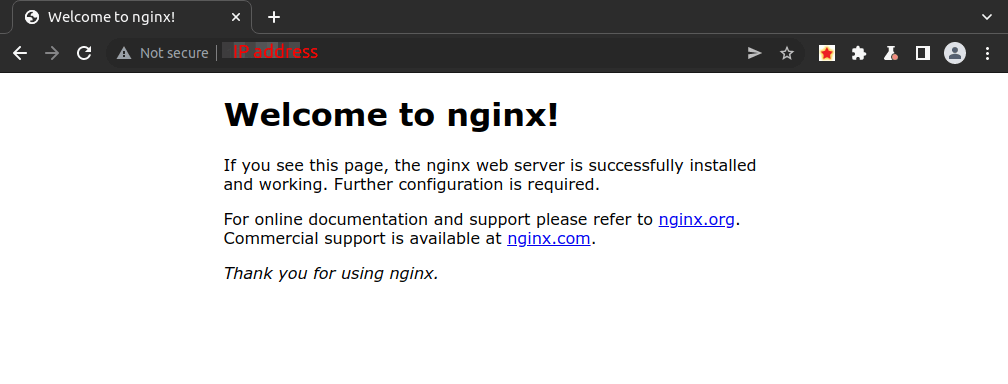
If the connection is refused or failed to complete, there might be a firewall preventing incoming requests to TCP port 80. If you are using iptables firewall, then you need to run the following command to open TCP port 80.
sudo iptables -I INPUT -p tcp --dport 80 -j ACCEPT
If you are using the UFW firewall, then run this command to open TCP port 80.
sudo ufw allow http
Finally, we need to make www-data (Nginx user) as the owner of web directory. By default, it’s owned by the root user.
sudo chown www-data:www-data /usr/share/nginx/html -R
Step 3: Install MariaDB Database Server
MariaDB is a drop-in replacement for MySQL. It is developed by former members of MySQL team who are concerned that Oracle might turn MySQL into a closed-source product. Enter the following command to install MariaDB on Ubuntu 24.04.
sudo apt install mariadb-server mariadb-client
After it’s installed, MariaDB server should be automatically started. Use systemctl to check its status.
systemctl status mariadb
Output:
● mariadb.service - MariaDB 10.11.7 database server Loaded: loaded (/lib/systemd/system/mariadb.service; enabled; vendor preset: enabled) Active: active (running) since Fri 2022-05-10 14:19:16 UTC; 18s ago Docs: man:mysqld(8) https://mariadb.com/kb/en/library/systemd/ Main PID: 9161 (mysqld) Status: "Taking your SQL requests now..." Tasks: 31 (limit: 9451) Memory: 64.7M CGroup: /system.slice/mariadb.service └─9161 /usr/sbin/mysqld
Hint: If the above command doesn’t immediately quit after running. You need to press “q” to make it quit.
If it’s not running, start it with this command:
sudo systemctl start mariadb
To enable MariaDB to automatically start at boot time, run
sudo systemctl enable mariadb
Now run the post-installation security script.
sudo mysql_secure_installation
- When it asks you to enter MariaDB root password, press
Enterkey as the root password isn’t set yet. - Don’t switch to unix_socket authentication because MariaDB is already using unix_socket authentication.
- Don’t change the root password, because you don’t need to set root password when using unix_socket authentication.
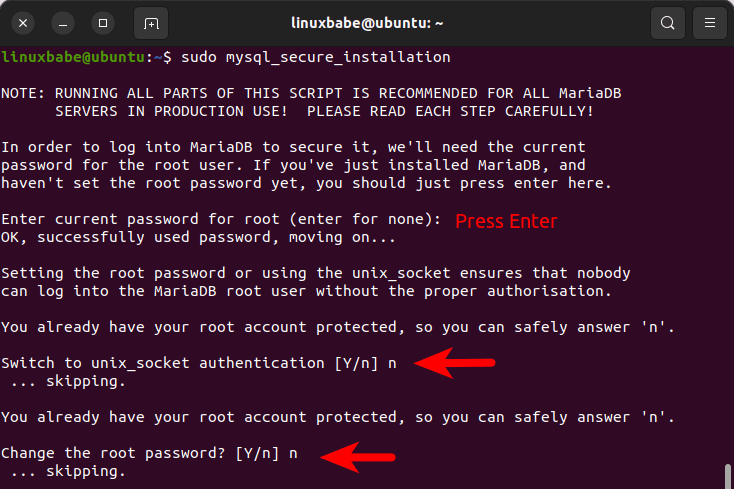
Next, you can press Enter to answer all remaining questions, which will remove anonymous user, disable remote root login and remove test database. This step is a basic requirement for MariaDB database security. (Notice that Y is capitalized, which means it is the default answer. )
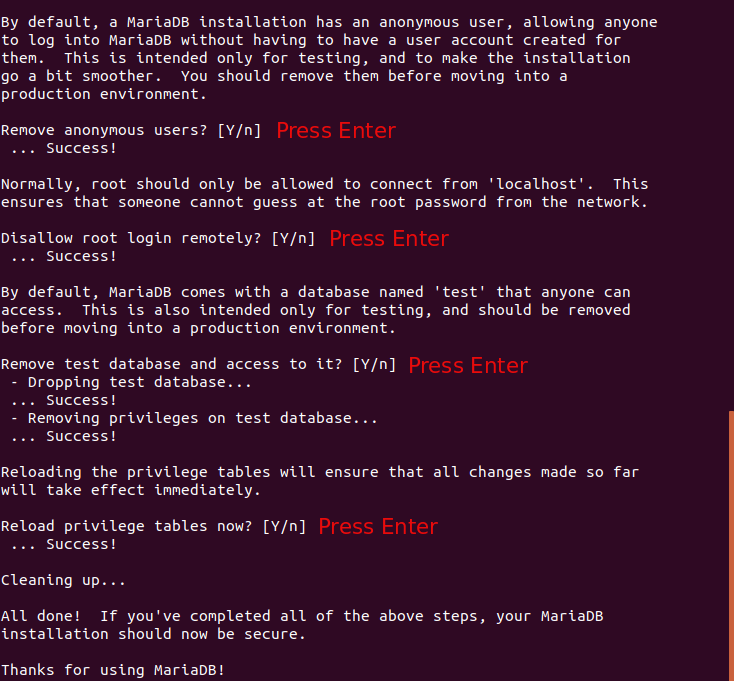
By default, the MaraiDB package on Ubuntu uses unix_socket to authenticate user login, which basically means you can use username and password of the OS to log into MariaDB console. So you can run the following command to log in without providing MariaDB root password.
sudo mariadb -u root
To exit, run
exit;
Check MariaDB server version information.
mariadb --version
As you can see, we have installed MariaDB 10.11.7.
mariadb Ver 15.1 Distrib 10.11.7-MariaDB, for debian-linux-gnu (x86_64) using EditLine wrapper
Step 4: Install PHP 8.3
PHP 8.3 is included in Ubuntu 24.04 repository and has a minor performance improvement over PHP 8.2. Enter the following command to install PHP 8.3 and some common extensions.
sudo apt install php8.3 php8.3-fpm php8.3-mysql php-common php8.3-cli php8.3-common php8.3-opcache php8.3-readline php8.3-mbstring php8.3-xml php8.3-gd php8.3-curl
PHP extensions are commonly needed for content management systems (CMS) like WordPress. For example, if your installation lacks php8.3-xml, then some of your WordPress site pages may be blank and you can find an error in Nginx error log like:
PHP message: PHP Fatal error: Uncaught Error: Call to undefined function xml_parser_create()
Installing these PHP extensions ensures that your CMS runs smoothly. Now start php8.3-fpm.
sudo systemctl start php8.3-fpm
Enable auto-start at boot time.
sudo systemctl enable php8.3-fpm
Check status:
systemctl status php8.3-fpm
Sample output:
● php8.3-fpm.service - The PHP 8.3 FastCGI Process Manager Loaded: loaded (/lib/systemd/system/php8.3-fpm.service; enabled; vendor pr> Active: active (running) since Fri 2024-05-10 14:40:26 UTC; 12s ago Docs: man:php-fpm8.1(8) Process: 21019 ExecStartPost=/usr/lib/php/php-fpm-socket-helper install /ru> Main PID: 21012 (php-fpm8.1) Status: "Processes active: 0, idle: 2, Requests: 0, slow: 0, Traffic: 0req> Tasks: 3 (limit: 9451) Memory: 9.4M CGroup: /system.slice/php8.3-fpm.service ├─21012 php-fpm: master process (/etc/php/8.1/fpm/php-fpm.conf) ├─21017 php-fpm: pool www └─21018 php-fpm: pool www
If the above command doesn’t immediately quit after running. You need to press “q” to make it quit.
Step 5: Create an Nginx Server Block
An Nginx server block is like a virtual host in Apache. We will not use the default server block because it’s inadequate to run PHP code and if we modify it, it becomes a mess. So remove the default symlink in sites-enabled directory by running the following command. (It’s still available as /etc/nginx/sites-available/default.)
sudo rm /etc/nginx/sites-enabled/default
Then use a command-line text editor like Nano to create a new server block file under /etc/nginx/conf.d/ directory.
sudo nano /etc/nginx/conf.d/default.conf
Paste the following text into the file. The following snippet will make Nginx listen on IPv4 port 80 and IPv6 port 80 with a catch-all server name.
server {
listen 80;
listen [::]:80;
server_name _;
root /usr/share/nginx/html/;
index index.php index.html index.htm index.nginx-debian.html;
location / {
try_files $uri $uri/ /index.php;
}
location ~ \.php$ {
fastcgi_pass unix:/run/php/php8.3-fpm.sock;
fastcgi_param SCRIPT_FILENAME $document_root$fastcgi_script_name;
include fastcgi_params;
include snippets/fastcgi-php.conf;
}
# A long browser cache lifetime can speed up repeat visits to your page
location ~* \.(jpg|jpeg|gif|png|webp|svg|woff|woff2|ttf|css|js|ico|xml)$ {
access_log off;
log_not_found off;
expires 360d;
}
# disable access to hidden files
location ~ /\.ht {
access_log off;
log_not_found off;
deny all;
}
}
Save and close the file. (To save a file in Nano text editor, press Ctrl+O, then press Enter to confirm. To exit, press Ctrl+X.)
Then test Nginx configurations.
sudo nginx -t
If the test is successful, reload Nginx.
sudo systemctl reload nginx
Step 6: Test PHP
To test PHP-FPM with Nginx Web server, we need to create a info.php file in the webroot directory.
sudo nano /usr/share/nginx/html/info.php
Paste the following PHP code into the file.
<?php phpinfo(); ?>
Save and close the file. Now in the browser address bar, enter server-ip-address/info.php. Replace sever-ip-address with your actual IP. If you follow this tutorial on your local computer, then type 127.0.0.1/info.php or localhost/info.php.
You should see your server’s PHP information. This means PHP scripts can run properly with Nginx web server.
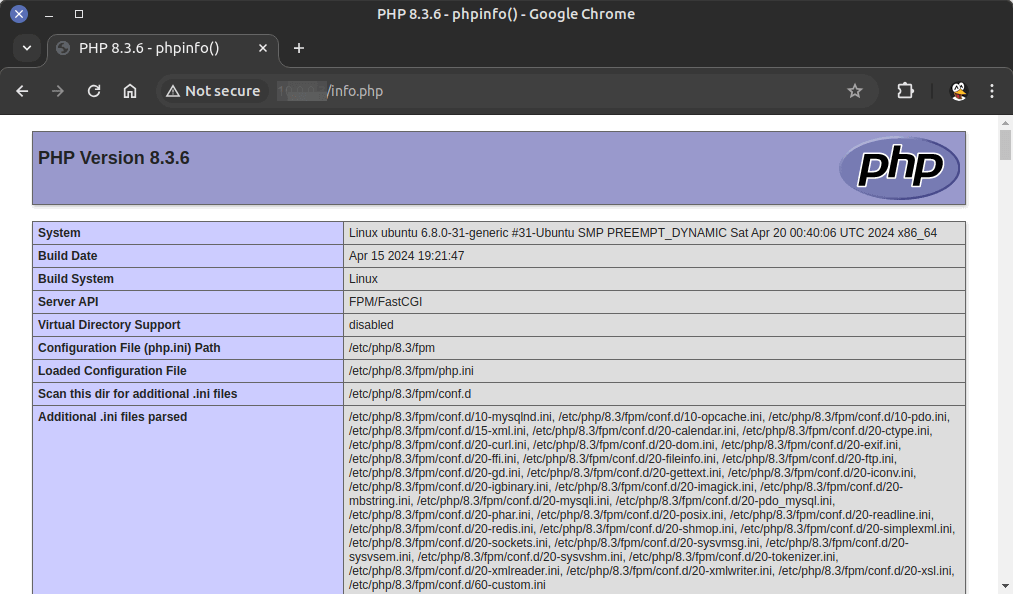
Step 7: Improve PHP Performance
The default PHP configurations (/etc/php/8.3/fpm/php.ini) are made for servers with very few resources (like a 256MB RAM server). To improve web application performance, you should change some of them.
We can edit the PHP config file (php.ini), but it’s a good practice to create a custom PHP config file, so when you upgrade to a new version of PHP 8.3, your custom configuration will be preserved.
sudo nano /etc/php/8.3/fpm/conf.d/60-custom.ini
In this file, add the following lines.
; Maximum amount of memory a script may consume. Default is 128M memory_limit = 512M ; Maximum allowed size for uploaded files. Default is 2M. upload_max_filesize = 20M ; Maximum size of POST data that PHP will accept. Default is 2M. post_max_size = 20M ; The OPcache shared memory storage size. Default is 128 opcache.memory_consumption=256 ; The amount of memory for interned strings in Mbytes. Default is 8. opcache.interned_strings_buffer=32
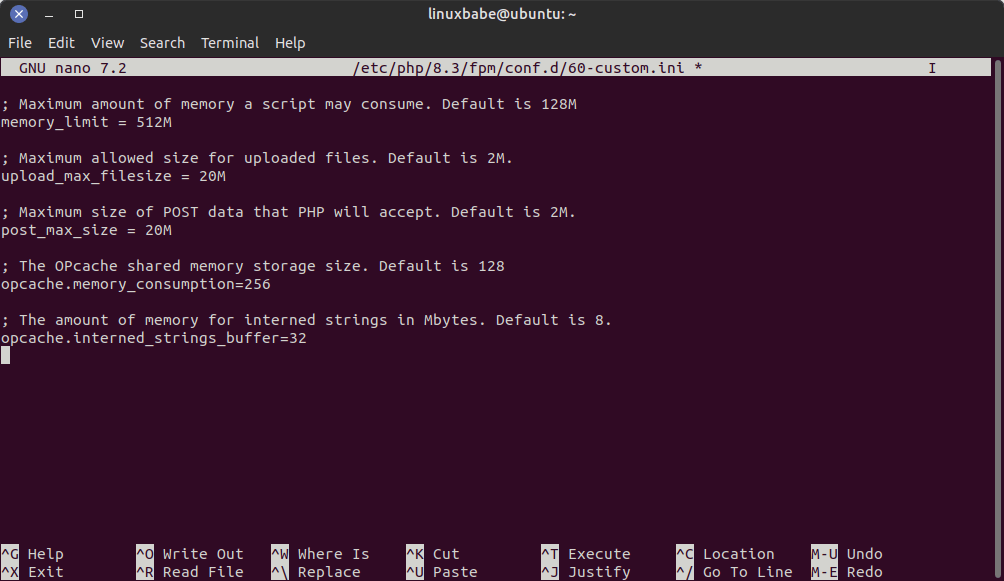
Save and close the file. Then reload PHP 8.3-FPM for the changes to take effect.
sudo systemctl reload php8.3-fpm
OPcache improves the performance of PHP applications by caching precompiled bytecode. You can view OPcache stats via the info.php page. Below is a before and after comparison on one of my servers.
Before
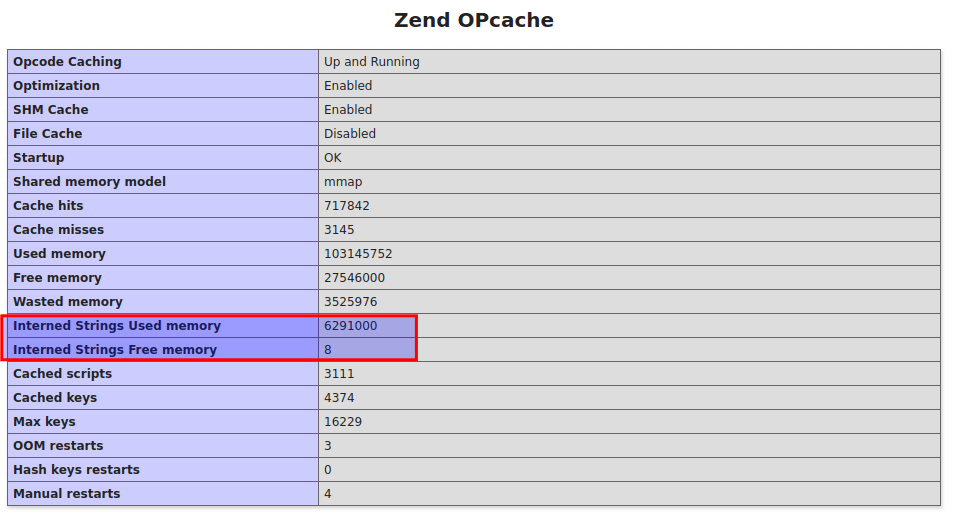
After
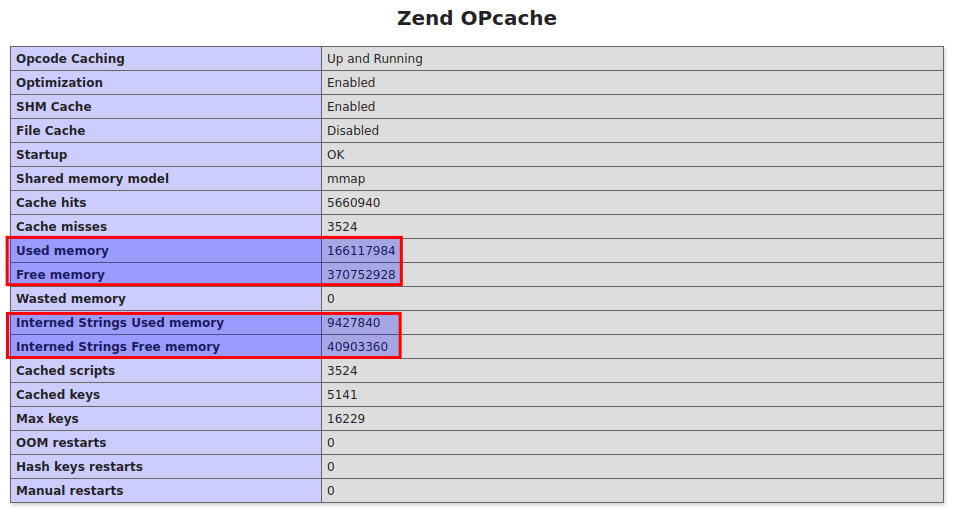
As you can see, before applying the custom PHP configuration, the RAM allocated to OPcache is almost used up. After applying the custom PHP configurations, OPcache is able to use more RAM for caching precompiled bytecode.
Congrats! You have successfully installed Nginx, MariaDB, and PHP 8.3 on Ubuntu 24.04. For your server’s security, you should delete info.php file now to prevent hackers from seeing it.
sudo rm /usr/share/nginx/html/info.php
Troubleshooting Tip
If you encounter errors, you can check the Nginx error log (/var/log/nginx/error.log) to find out what’s wrong.
Nginx Automatic Restart
If for any reason your Nginx process is killed, you need to run the following command to restart it.
sudo systemctl restart nginx
Instead of manually typing this command, we can make Nginx automatically restart by editing the nginx.service systemd service unit. To override the default systemd service configuration, we create a separate directory.
sudo mkdir -p /etc/systemd/system/nginx.service.d/
Then create a file under this directory.
sudo nano /etc/systemd/system/nginx.service.d/restart.conf
Add the following lines in the file, which will make Nginx automatically restart 5 seconds after a failure is detected. The default value of RetartSec is 100ms, which is too small. Nginx may complain that “start request repeated too quickly” if RestartSec is not big enough.
[Service] Restart=always RestartSec=5s
Save and close the file. Then reload systemd for the changes to take effect.
sudo systemctl daemon-reload
To check if this would work, kill Nginx with:
sudo pkill nginx
Then check Nginx status. You will find Nginx automatically restarted.
systemctl status nginx
MariaDB Automatic Start
By default, MariaDB is configured to automatically restart on-abort (/lib/systemd/system/mariadb.service). However, if your server runs out of memory (oom) and MariaDB is killed by the oom killer, it won’t automatically restart. We can configure it to restart no matter what happens.
Create a directory to store custom configurations.
sudo mkdir -p /etc/systemd/system/mariadb.service.d/
Create a custom config file.
sudo nano /etc/systemd/system/mariadb.service.d/restart.conf
Add the following lines in the file.
[Service] Restart=always RestartSec=5s
Save and close the file. Then reload systemd for the changes to take effect.
sudo systemctl daemon-reload
Next Steps
As always, if you found this post useful, then subscribe to our free newsletter to get more tips and tricks. You can also install WordPress on top of the LEMP stack to create your own website or blog.
Related Nginx tutorials:
Backup is important in case of hacking, data center disasters, etc. You should have a backup strategy for your server.
- Back Up and Restore MariaDB Databases From the Command line
- Use Duplicati to Back Up Files on Debian, Ubuntu, Linux Mint
Linux Server Performance Tuning and Monitoring
- Easily Boost Ubuntu Network Performance by Enabling TCP BBR
- What is HTTP/2 and How to Enable it on Nginx
- Linux Server Performance Monitoring with Netdata (2022)
Take care 🙂



good
Best ever.
You are welcome.
Thank you so much for this tutorial!
Clear, concise and best of all, worked without problem
Testing the validity of the nginx configuration file gives me an error. Can you help?
line 14 is:
line 14 looks good. Perhaps the error is in previous line, like a missing semicolon.
No luck. I think it might be this: https://mariadb.com/kb/en/library/unable-to-install-mariadb-101-on-ubuntu-1804-after-apt-remove-purge-mysql/
I did have mysql installed previously, and today I started over with my whole server (reinstalled Ubuntu 24.04 from usb stick) because I was stuck and decided to follow your steps (also for Nextcloud).
Maybe I should reformat the drive, as I am only at the very beginning?
You can add the official MairaDB repository https://mariadb.com/kb/en/library/mariadb-package-repository-setup-and-usage/
Then install mariadb-server and mariadb-client.
If this doesn’t work, reinstall your Ubuntu 24.04 system.
Hi,
I’ve looked at a lot of different tutorials online and yours are by far the most clear and concise. I like that you explain what everything does in simple terms each step of the way.
Maybe this is obvious, but where you write ‘www-data’ above, that can be any name, right?
Nginx is running as the
www-datauser, which is defined in/etc/nginx/nginx.conffile.output:
So you can’t use other name.
ok, thanks!
For step 3, I’m getting:
Any ideas?
mariadb-server and mariadb-client are in the default Ubuntu repository (universe). Make sure it’s enabled by executing the following command.
Then
Thank you – I’ll try that.
Thank you – I’ll try that.
Edit: that worked!
It’s weird – everything installed but when I type:
sudo mariadb -u root
it says:
sudo: mariadb: command not found.
Same with:
mariadb –version
It doesn’t seem to recognise mariadb as a command, even though mariadb is active and running.
Use mysql command.
That brings up Access denied for user ‘root’@;’localhost’ (using password: NO)
Then use the following command.
Provide the MariaDB root password.
Thank you, Xiao. That seems to work. For the ‘version’ command, I also have to type mysql –version instead of mariadb for it to work.
Thank you for your time!
Hi Xiao
Thank you for your excellent howtos … I have used a few over a long time now. I am having a problem with the php part. Specifically I am getting the message
So a little bit of hunting around and I have found this …
typing
returns the following …
So modules php7.2-fpm and php7.2-mbstring are apparently missing, so how do I get them?
php7.2-fpm and php7.2-mbstring are in the default Ubuntu 18.04 repository. https://packages.ubuntu.com/bionic/php7.2-fpm
There might be a problem with the repository mirror you are using.
Thank you Xiao
I am using a clean install of Ubuntu 18.01 which I have spun up on a VMware VM using an official sourced ISO to install.
here is my sources.list file in total …
I tried using us.archive. etc but that didn’t work, I tried adding a packages.ubuntu. etc but that didn’t work either. I seem to be missing something …
Can you please advise what I need to have in my sources.list file?
Thank you again.
hi, help me. after installation nextcloud on my ubuntu server 18.04. when i running on address bar with ip address. i found not success nextcloud it
Your sources.list file only contains the
maincomponent, you need to add theuniversecomponent.mysite.com/lnfo.php 404 Not Found access.log
Hello, is there any tutorial on how to enable brotli compression on latest nginx server ?
Thanks a lot for your tutorial. Everything worked fine by just cutting and pasting the commands.
Hi, thanks for the tutorial, everthing seems to work except the nginx to nextcloud connection. I’m running a Ryzen3 local server on lan – no outside connection yet, I’m connected to 192.168.0.100 and get
Welcome to nginx!
If you see this page, the nginx web server is successfully installed and working. Further configuration is required.
For online documentation and support please refer to nginx.org.
Commercial support is available at nginx.com.
Thank you for using nginx.
I’ve edited /etc/nginx/conf.d/nextcloud.conf
and tried a few options
#listen 80;
listen 80 default_server;
listen [::]:80 default_server;
#server_name nextcloud.192.168.0.100;
#server_name 192.168.0.100/nextcloud;
server_name _;
But I can’t get to the nextcloud installer page – any ideas ?
Do you recommend to create separate spools owned by different users to separate the server blocks from each other?
I’m confused.
Every other guide I’ve seen for Ubuntu create new server block under
/etc/nginx/sites-available/
while this guide says
/etc/nginx/conf.d/
What is the difference?
/etc/nginx/sites-available/ is for storing the actual virtual host/server block file.
/etc/nginx/sites-enabled/ contains symbolic links to the /etc/nginx/available/ directory.
In /etc/nginx/nginx.conf file, you can find the following two lines.
include /etc/nginx/conf.d/*.conf; include /etc/nginx/sites-enabled/*;which means virtual host/server block files in /etc/nginx/conf.d/ and /etc/nginx/sites-enabled/ directories will be loaded by Nginx.
If you create virtual host/server block file in /etc/nginx/sites-available/ directory, then you must create a symbolic link in /etc/nginx/sites-enabled/ directory. (This is a Debian/Ubuntu tradition.)
I personally prefer to use /etc/nginx/conf.d/ directory, because it’s easy to type and I don’t need to create symbolic links. The upstream Nginx package uses this directory by default.
I have come across a problem when i put a different server name and server, as ll it does is giving me a 502 bad gateway when i go to web.prueba.local. This is the edit i did to the server block :
server { listen 80; listen [::]:80; server_name web.prueba.local; root /usr/share/prueba; index index.php index.html index.htm index.nginx-debian.html; location / { try_files $uri $uri/ /index.php; }I have a folder in /usr/share/prueba and it only has a index.php file
Apparently the problem comes from fastcgi_pass unix:/run/php/php7.2-fpm.sock; changed it to fastcgi_pass unix:/run/php7.2-fpm.sock; and is working now.
Im using mint 19, by the way.
Step 6: Test PHP
There are not instructions to open Ubuntu server port 80 to TCP traffic before testing server-ip-address/info.php in a browser.
Regards, Jeff
Opening ports, configuring firewalls and setting protection tools, managing DNS and setting up domains are not part of the scope of this guide… or any install LEMP/LAMP guide.
To install PHP 8.2 on Ubuntu 24.04:
Add the Ondrej PPA to your system, which contains all versions of PHP packages for Ubuntu systems.: `LC_ALL=C.UTF-8 sudo add-apt-repository ppa:ondrej/php`
run `sudo apt update`
You should be able to install any PHP version
Great guide, thank you very much!
THANKS! 5/5 guide. 11/10 actually.
Had to use this guide because my server still runs this old as* ubuntu.
The guide is flawless. I used it 3 times with no errors in 2 different servers.
Now I’m going to check de wordpress guide.